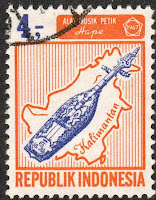INDONESIA.
Musical instruments.
Borneo (Kalimantan) Map and sape.
Eighth stamp in a set of 16, issued on 01.02.1967.
Face value: 4 Indonesian rupiah.
Printing: Photogravure.
Size: 25 x 32 mm.
Catalogs
- Michel No. 569.
- Scott No. 712.
- StampWorld No. 611.
- Stanley Gibbons No. 1147.
- Yvert et Tellier No. 505.
- Zonnebloem No. 570.
The sape (sapeh or hape) is a traditional lute of the communities who live on the banks of the rivers of East Kalimantan. Sapes are carved from a single bole of wood, and many modern instruments reaching over a metre in length. Initially the sape was a fairly limited instrument with two strings and only three frets. Its use was restricted to a form of ritualistic music to induce trance. Gradually the sape became a social instrument to accompany dances or as a form of entertainment. Today, three, four or five-string instruments are used, with a range of more than three octaves.

No comments:
Post a Comment